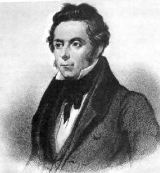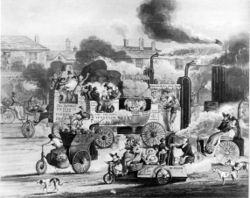
Walter Hancock
Encyclopedia

Victorian era
The Victorian era of British history was the period of Queen Victoria's reign from 20 June 1837 until her death on 22 January 1901. It was a long period of peace, prosperity, refined sensibilities and national self-confidence...
period. He is chiefly remembered for his steam
Steam
Steam is the technical term for water vapor, the gaseous phase of water, which is formed when water boils. In common language it is often used to refer to the visible mist of water droplets formed as this water vapor condenses in the presence of cooler air...
powered road vehicles, but also received a patent for preparing and cutting indiarubber into sheets. He was the younger brother of Thomas Hancock
Thomas Hancock (inventor)
Thomas Hancock , elder brother of inventor Walter Hancock, was an English inventor who founded the British rubber industry...
, the inventor of rubber mastication who is also claimed by some to be the inventor of rubber vulcanization
Vulcanization
Vulcanization or vulcanisation is a chemical process for converting rubber or related polymers into more durable materials via the addition of sulfur or other equivalent "curatives." These additives modify the polymer by forming crosslinks between individual polymer chains. Vulcanized material is...
.
Hancock's steam buses
Between 1824 and 1836, Hancock constructed at his StratfordStratford, London
Stratford is a place in the London Borough of Newham, England. It is located east northeast of Charing Cross and is one of the major centres identified in the London Plan. It was historically an agrarian settlement in the ancient parish of West Ham, which transformed into an industrial suburb...
works a number of steam road vehicles, one of these being a three-wheeled four-seater car. In 1827 Hancock also patented a steam boiler that would split rather than blow (explode) so that the passengers being carried on his steam vehicles would be able to travel in safety.
In 1829 he built a small ten-seater bus called the Infant, with which in 1831 he began a regular service between Stratford and London. This vehicle was made famous by its later revenue-earning journeys from London to Brighton
Brighton
Brighton is the major part of the city of Brighton and Hove in East Sussex, England on the south coast of Great Britain...
, which were a British first, and also demonstrated its usability by successfully ascending a frozen slope of 5 degrees where horse-drawn coaches were struggling. The vehicle was ultimately lost in an accident when the driver blocked the safety valve
Safety valve
A safety valve is a valve mechanism for the automatic release of a substance from a boiler, pressure vessel, or other system when the pressure or temperature exceeds preset limits....
in order to increase the starting pressure and the boiler exploded.
On the 31st of October, 1832, the "Infant" took an experimental trip to Brighton, which was documented in Mr. Alexander Garden's "Journal of Elemental Locomotion.
On 22 April 1833 Hancock’s steam omnibus The Enterprise (built for the London and Paddington Steam Carriage Company) began a regular service between London Wall and Paddington via Islington. It was the first regular steam carriage service, and was the first mechanically propelled vehicle specially designed for omnibus
Bus
A bus is a road vehicle designed to carry passengers. Buses can have a capacity as high as 300 passengers. The most common type of bus is the single-decker bus, with larger loads carried by double-decker buses and articulated buses, and smaller loads carried by midibuses and minibuses; coaches are...
work to be operated.
The service was brought to an end due to a dispute between Hancock and the operators, and Hancock himself built and operated further steam buses between 1833 and 1840.
In 1836 he introduced the 22-seat Automaton, which ran over 700 journeys between London and Paddington, London and Islington, and Moorgate and Stratford, carrying over 12,000 passengers in total and regularly travelling at speeds in excess of 20 mph.
By 1840, however, the development of steam-powered road vehicles had lost impetus and the heavy road tolls imposed by the Turnpike Acts had turned inventors away from steam. Hancock was forced to give up the struggle, and the way was left clear for the operators of horse buses.
Hancock continued working with steam and supplied a light engine (similar to his steam road coaches) to the Eastern Counties Railway. The boiler consisted of separate chambers which greatly reduced the risk of explosion.
Hancock's "Enterprise"
Hancock's "Enterprise" steam bus had several features which were innovatory by contemporary standards. The engine was suspended on leaf springs along with the body of the vehicle, and the axle located with swinging arms as is still done today in the Ford ExplorerFord Explorer
The Ford Explorer is a sport-utility vehicle sold in North America and built by the Ford Motor Company since 1990, as a replacement for the smaller but related Ford Bronco II. It is manufactured in Chicago, Illinois...
, with power being transmitted to the axle using chain drive. The rear axle was also used to drive a centrifugal blower fan which was used to force air into the firebox.
The "Enterprise" required three operators in normal running. The driver sat at the front and was responsible for steering (via a steering wheel rather than a tiller
Tiller
A tiller or till is a lever attached to a rudder post or rudder stock of a boat that provides leverage for the helmsman to turn the rudder...
) and controlling the speed via a regulator. A second operator occupied a small compartment to the rear of the vehicle between the boiler and the engine; this man was responsible for looking after the boiler's water level and selecting reverse gear when required. The final man stood on a platform at the rear and was responsible for maintaining the fire and braking, which was carried out by means of a large lever which acted directly on one of the rear wheels. Nothing is known about how these three people communicated.
Statistics
Hancock compiled some statistics of his operations. Over a total distance of 4200 mi (6,759.2 km), he had carried 12,761 passengers. He had made 143 round trips from the City to Paddington, 525 trips from the City to Islington, and 44 to Stratford. 55 chaldronChaldron
A chaldron was a dry English measure of volume, mostly used for coal; the word itself is an obsolete spelling of cauldron...
s of coke
Coke (fuel)
Coke is the solid carbonaceous material derived from destructive distillation of low-ash, low-sulfur bituminous coal. Cokes from coal are grey, hard, and porous. While coke can be formed naturally, the commonly used form is man-made.- History :...
fuel were used (roughly 165 tons), equalling 76 mi (122.3 km) per chaldron; at 12s (60p) per chaldron, this equalled 2d per mile. Hancock's statistics also included the hours in service each day, which averaged 5 hrs 17 mins per vehicle, while the average time taken to make the 9 mi (14.5 km) round trip from Moorgate to Paddington was 1 hr 10 mins.

